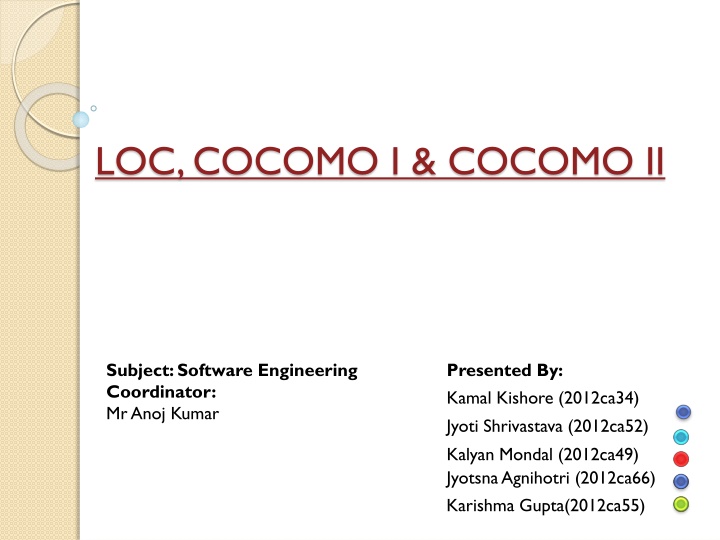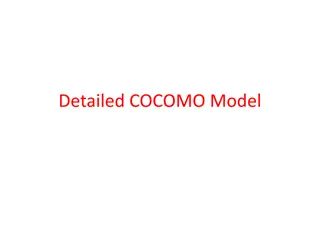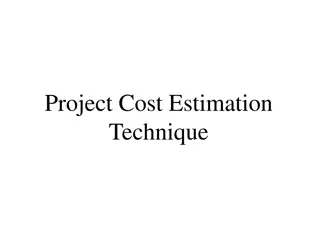
Software Engineering Essentials: LOC, Function Point, COCOMO
Dive into software planning, lines of code (LOC), function point measurement, and COCOMO models for cost estimation. Understand the significance of these concepts in software development projects.
Download Presentation

Please find below an Image/Link to download the presentation.
The content on the website is provided AS IS for your information and personal use only. It may not be sold, licensed, or shared on other websites without obtaining consent from the author. If you encounter any issues during the download, it is possible that the publisher has removed the file from their server.
You are allowed to download the files provided on this website for personal or commercial use, subject to the condition that they are used lawfully. All files are the property of their respective owners.
The content on the website is provided AS IS for your information and personal use only. It may not be sold, licensed, or shared on other websites without obtaining consent from the author.
E N D
Presentation Transcript
LOC, COCOMO I & COCOMO II Subject: Software Engineering Coordinator: Mr Anoj Kumar Presented By: Kamal Kishore (2012ca34) Jyoti Shrivastava (2012ca52) Kalyan Mondal (2012ca49) JyotsnaAgnihotri (2012ca66) Karishma Gupta(2012ca55)
Contents Software Planning LOC: Lines of Code Function Point Cost Estimation Development Mode COCOMO I Basic COCOMO Intermediate COCOMO Detailed COCOMO COCOMO II Application Composition Early Design Model Post Architecture Model References
SOFTWARE PLANNING Software planning begins before technical work starts, continues as the software Evolves from concept to reality, and culminates only when the software is retired. Fig:-Activities during software project planning Ref :-software engineering by K.K.Agrawal, yogesh singh Created by:- Kamal kishore(2012ca34)
LINES OF CODE(LOC) A Line of code is any line of program text that is not a comment or blank line, regardless of the number of statements or fragments on the line. This specifically includes all lines containing program header, declarations, and executable and non-executable statements. While line of codes have their uses, their usefulness is limited for other tasks like functionality, complexity, efficiency, etc. Ref :-software engineering by K.K.Agrawal, yogesh singh Created by:- Kamal kishore(2012ca34)
FUNCTION POINT Function point measures functionality which is a solution to the size measurement problem. It is decomposed into following functional units Internal Logical Files External Interface Files Inputs Outputs Enquiries Ref :-software engineering by K.K.Agrawal, yogesh singh Created by:- Kamal kishore(2012ca34)
FUNCTIONAL UNITS WITH WEIGHTING FACTORS Functional units External Inputs External Outputs External Inquiries Internal logical files (ILF) External interface files (EIF) Low 3 4 3 7 5 Average 4 5 4 10 7 High 6 7 5 15 10 The procedure for the calculation of UFP in mathematical form is given below 5 3 UFP = ???WijUFP : Unadjusted Function Point j=1 Where i indicates the row and j indicates the column of table. Wij: It is the entry of ithrow and jthcolumn of the table. Zij: It is the count of the number of functional unit of type i that have been classified as having the complexity corresponding to column j i=1 Ref :-software engineering by K.K.Agrawal, yogesh singh Created by:- Kamal kishore(2012ca34)
An example Consider a project with the following functional units: 50 user inputs,40 user outputs, 35 user enquiries,6 user files,4 external interfaces. Assume all complexity adjustment factors and weighting factors are average. Compute the function points for the project. Suppose that program needs 70 LOC per FP. Find out the size of complete project. Solution: 5 3 UFP = ???Wij i=1 j=1 UFP= 50 * 4 + 40 * 5 + 35 * 4 + 6 * 10 + 4 * 7 = 200+200+140+60+28 = 628 CAF= (0.65 + ??) =(0.65 + 0.01 (14 * 3 )) = 1.07 FP= UFP * CAF =628 * 1.07 = 672 Size = FP * (LOC per FP) = 672 * 70 = 47040 LOC Ref :-software engineering by K.K.Agrawal, Yogesh Singh Created by:- Kamal kishore(2012ca34)
Cost Estimation Approximate judgement of the costs for a project. It should be done throughout the entire life cycle. Why we need? To determine how much effort and time a software project requires. Important for making good management decisions. It facilitates competitive contract bids. It affect the planning and budgeting of a project. Ref: Software Engineering By K.K.Aggarwal & Y. Singh Created by: Jyoti Shrivastava
Development Mode of S/W Projects Mode Project Size Nature of Project Innovation Deadline Organic Typically 2-50 KLOC Small size project, Experienced developers. Little Not Tight Semi Detached Typically 50- 300KLOC Medium size project and team. Medium Medium Embedded Typically over 300KLOC Large project, Real- time systems Significant Tight
Constructive Cost Model(COCOMO ) The COCOMO model is a single variable software cost estimation model developed by Barry Boehm in 1981. The model uses a basic regression formula, with parameters that are derived from historical project data and current project characteristics. Hierarchy of Cocomo Model 1. Basic COCOMO model 2. Intermediate COCOMO model 3. Detailed COCOMO model Ref: Software Engineering By K.K.Aggarwal & Y. Singh Created by: Jyoti Shrivastava
Basic COCOMO Model It take the form: Effort(E) = ab* (KLOC)bb(in Person-months) DevelopmentTime(D) = cb* (E) db(in month) Average staff size(SS) = E/D (in Person) Productivity(P) = KLOC / E (in KLOC/Person-month) Project Organic ab 2.4 bb 1.05 cb 2.5 db 0.38 Semidetached 3.0 1.12 2.5 0.35 Embedded 3.6 1.20 2.5 0.32 Ref: Software Engineering By K.K.Aggarwal & Y. Singh Created by: Jyoti Shrivastava
Person-Months What is Person-Months ? The area under the curve Ref: Fundamentals of Software Engineering By Rajib Mall Created by: Jyoti Shrivastava
Basic cocomo: Example A project size of 200KLOC is to be developed.S/W development team has average experience on similar type of projects.The project schedule is not very tight.Calculate the effort and development time of the project. Ans: 200 KLOC implies semi-detached mode. Hence, E= 3.0 * (200)1.12= 1133.12 PM D=2.5 * (1133.12)0.35= 29.3 M Avg. staff size(SS) = E/D = 1133.12/29.3=38.67 Persons. Productivity (P) = KLOC/E = 200/1133.12=0.1765 KLOC/PM. Ref: Software Engineering By K.K.Aggarwal & Y. Singh Created by: Jyoti Shrivastava
Intermediate COCOMO Extension of Basic COCOMO Why Use ? Basic model lacks accuracy Computes software development effort as a function of program size and set of 15 Cost Drivers Cost Driver: A multiplicative factor that determines the effort required to complete the software project. Why Cost Drivers? Adjust the nominal cost of a project to the actual project Environment. For each Characteristics, Estimator decides the scale factor Very High Extra High Very Low Low High Nominal Ref: Software Engineering By K.K.Aggarwal & Y. Singh Created by: Kalyan Mondal
Cost Drivers Product Attributes Required Software Reliability (RELY) Database Size (DATA) Product Complexity (CPLX) Execution Time Constraint (TIME) Main Storage constraint (STOR) Virtual Machine volatility (VIRT) Computer turnaround time (TURN) Computer Attributes Analyst Capability (ACAP) Application Experience (AEXP) Programmer Capability (PCAP) Virtual Machine Experience (VEXP) Programming language Experience (LEXP) Personnel Attributes Project Attributes Modern programming practices (MODP) Use of Software tools (TOOL) Required development schedule (SCED) Ref: Software Engineering By K.K.Aggarwal & Y. Singh Created by: Kalyan Mondal
The Calculation Multiply all 15 Cost Drivers to get Effort Adjustment Factor(EAF) E(Effort) = ab(KLOC)bb * EAF(in Person-Month) D(Development Time) = cb(E)db (in month) SS (Avg Staff Size) = E/D (in persons) P (Productivity) = KLOC/E (in KLOC/Person-month) Project Organic ab 3.2 bb 1.05 cb 2.5 db 0.38 Semidetached 3.0 1.12 2.5 0.35 Embedded 2.8 1.20 2.5 0.32 Ref: Software Engineering By K.K.Aggarwal & Y. Singh Created by: Kalyan Mondal
Intermediate COCOMO : Example A new project with estimated 400 KLOC embedded system has to be developed. Project manager hires developers of low quality but a lot of experience in programming language. Calculate the Effort, Development time, Staff size & Productivity. Cost Drivers Very Low 1.29 1.14 Low Nominal High Very High 0.82 -- Extra High AEXP LEXP 1.13 1.07 1.00 1.00 0.91 0.95 -- -- EAF = 1.29 * 0.95 = 1.22 400 LOC implies Embedded System Effort = 2.8*(400)1.20 * 1.225 = 3712 * 1.22 = 4528 person-months Development Time = 2.5 * (4528)0.32= 2.5 * 14.78 = 36.9 months Avg. Staff Size = E/D = 4528/36.9 = 122 persons Productivity = KLOC/Effort = 400/4528 = 0.0884 KLOC/person-month Ref: Software Engineering By K.K.Aggarwal & Y. Singh Created by: Kalyan Mondal
Detailed COCOMO Detailed COCOMO = Intermediate COCOMO + assessment of Cost Drivers impact on each phase. Phases 1) Plans and requirements 2) System Design 3) Detailed Design 4) Module code and test 5) Integrate and test Cost of each subsystem is estimated separately. This reduces the margin of error. Ref: Software Engineering By K.K.Aggarwal & Y. Singh Created by: Kalyan Mondal
The Calculation Multiply all 15 Cost Drivers to get Effort Adjustment Factor(EAF) E(Effort) = ab(KLOC)bb * EAF(in Person-Month) D(Development Time) = cb(E)db (in month) Ep(Total Effort) = p* E (in Person-Month) Dp(Total Development Time) = p* D (in month) Ref: Software Engineering By K.K.Aggarwal & Y. Singh Created by: Kalyan Mondal
Detailed COCOMO : Example Consider a project to develop a full screen editor. The major components identified and their sizes are (i) Screen Edit 4K (ii) Command Lang Interpreter 2K (iii) File Input and Output 1K (iv) Cursor movement 2K (v) Screen Movement 3K. Assume the Required software reliability is high, product complexity is high, analyst capability is high & programming language experience is low. Use COCOMO model to estimate cost and time for different phases. Size of modules : 4 + 2 + 1 + 2 + 3 = 13 KLOC [Organic] Cost Drivers Very Low 0.75 0.70 1.46 1.14 Low Nominal High Very High 1.40 1.30 0.71 -- Extra High RELY CPLX ACAP LEXP 0.88 0.85 1.19 1.07 1.00 1.00 1.00 1.00 1.15 1.15 0.86 0.95 -- 1.65 -- EAF = 1.15 * 1.15 * 0.86 * 1.07 = 1.2169 Ref: Software Engineering By K.K.Aggarwal & Y. Singh Created by: Kalyan Mondal
Example (Contd.) Initial Effort (E) = ab(KLOC)bb * EAF = 3.2*(12)1.05* 1.2169 = 52.9 person-months Initial Development Time = cb(E)db =2.5*(52.9)0.38= 11.29 months Phase value of p and p Plan & Reqr 0.06 0.10 System Design 0.16 0.19 Detail Design 0.26 0.24 Module code & test 0.42 0.39 Integration &Test 0.16 0.18 Organic Small p Organic Small p Phase wise effort & development time distribution E D Ep (in person-months) 0.06*52.9 = 3.17 0.16*52.9=8.46 0.26*52.9=13.74 0.42*52.9=22.21 0.16*52.9=8.46 Dp (in months) 0.10*11.29=1.12 0.19*11.29=2.14 0.24*11.29=2.70 0.39*11.29=4.40 0.18*11.29=2.03 Plan & Requirement System Design Detail Design Module code & test Integration & test 52.9 52.9 52.9 52.9 52.9 11.29 11.29 11.29 11.29 11.29 Ref: Software Engineering By K.K.Aggarwal & Y. Singh Created by: Kalyan Mondal
WHY COCOMO-II ? The changes in s/w development techniques included a move away from mainframe overnight batch processing to desktop- based real-time turnaround. These changes and others began to make applying the original COCOMO model problematic. The model is tuned to the life cycle practices of the 21st century. Ref: Software Engineering By K.K.Aggarwal & Y. Singh and csse website by : JyotsnaAgnihotri
Categories Identified By Cocomo II End User Programming Infrastructure Sector Intermediate Sectors 1. Application Generators And Composition Aids 2. Application Composition Sector 3. System Integration Stages Of Cocomo-II Application Composition Earlier Design Post Architecture Ref: Software Engineering By K.K.Aggarwal & Y. Singh by : JyotsnaAgnihotri
Application Composition Assess Object Counts Classification Of Complexity Levels Assign Complexity Weight To Each Object Determine Object Points Compute New Object Points Calculation Of Productivity Rate Compute The Effort In Person Months.
Assess object counts: Estimate the number of screens, reports and 3 GL components that will comprise this application. Classification of complexity levels: We have to classify each object instance (depending on values of its characteristics) into :- o simple o medium o Difficult Assign complexity weight to each object : The weights are used for three object types :- o screen o report o 3GL components Ref: Software Engineering By K.K.Aggarwal & Y. Singh by : JyotsnaAgnihotri
Determine object points: Add all the weighted object instances to get one number and this known as object-point count. Compute new object points: We have to estimate the percentage of reuse to be achieved in a project. Depending on the percentage reuse, the new object points (NOP) are computed. Object Points * (100 - %reuse) NOP = --------------------------------------------- 100 NOP are the object points that will need to be developed and differ from the object point count because there may be reuse( percentage of the Product development which is accomplished by exploiting the existence of existing component's design-or-development effort). Ref: Software Engineering By K.K.Aggarwal & Y. Singh&gilb.com by : JyotsnaAgnihotri
Calculation of productivity rate: The productivity rate can be calculated as: Productivity rate (PROD) = NOP/Person month Compute the effort in Persons-Months: When PROD is known, we may estimate effort in Person- Months as: NOP Effort in PM = ------------ PROD Ref: Software Engineering By K.K.Aggarwal & Y. Singh by : JyotsnaAgnihotri
Example Example: Consider a database application project with the following characteristics: The application has 4 screens with 4 views each and 7 data tables for 3 servers and 4 clients. The application may generate two report of 6 sections each from 07 data tables for two server and 3 clients. There is 10% reuse of object points. The developer s experience and capability in the similar environment is low. The maturity of organization in terms of capability is also low. Calculate the object point count, New object points and effort to develop such a project. Ref: Software Engineering By K.K.Aggarwal & Y. Singh by : JyotsnaAgnihotri
Solution : Lets have a look on the tables for screens, for reports , for complexity weights for each level No. Of Views Contained in a screen <3 clients) <3 Simple 3-7 Simple >8 Medium Total<4 (<2 servers Total<8 (2-3 servers 3-5 clients) Simple Medium Difficult Total 8+ (>3 servers >5 clients) Medium Difficult Difficult No. Of Sections Contained in a report Total<4 (<2 servers <3 clients) Total<8 (2-3 servers 3-5 clients) Total 8+ (>3 servers >5 clients) 0 or 1 2 or 3 4+ Simple Simple Medium Simple Medium Difficult Medium Difficult Difficult
Object Type Simple Complexity 1 2 - Medium Complexity 2 5 - Difficult Complexity 3 8 10 Screen Report 3GL This project comes under the category of application composition estimation model. Number of screens = 4 with 4 views each Number of reports = 2 with 6 sections each From Table we know that each screen will be of medium complexity and each report will be difficult complexity. Using Table of complexity weights, we may calculate object point count = 4 x 2 + 2 x 8 = 24 Ref: Software Engineering By K.K.Aggarwal & Y. Singh by : JyotsnaAgnihotri
Developers Experience And Capability Very low Low Nominal High Very high PROD (NOP/PM) 4 7 13 25 50 Using the formula NOP is calculated as: NOP= 24 * (100-10)/100=21.6 Low value of productivity is given in above Productivity table = 7 Efforts in PM=NOP/PROD=21.6/7=3.086 PM Ref: Software Engineering By K.K.Aggarwal & Y. Singh by : JyotsnaAgnihotri
Early Design Model Used in the early stages of a software project when very little may be known about: the size of the product to be developed, the nature of the target platform, the nature of the personnel to be involved in the project. Uses Unadjusted Function Points (UFP) as the measure of size. Based on a standard formula for COCOMO-II models: Where PMnominal = Effort of the project in person months A = Constant representing the nominal productivity, provisionally set to 2.5 B = Scale factor Size = Software size Created by- Karishma Gupta (2012CA55) Ref: Software Engineering By K.K. Aggarwal & Yogesh Singh 32
The Scaling Factors that COCOMO-II model uses for the calculation of B are: Precedentness (PREC) Development flexibility (FLEX) Architecture/ Risk Resolution (RESL) Team Cohesion (TEAM) Process maturity (PMAT) Early design cost drivers There are 7 early design cost drivers and are given below: 1. 2. 3. 4. 5. 6. 7. Product Reliability and Complexity (RCPX) Required Reuse (RUSE) Platform Difficulty (PDIF) Personnel Capability (PERS) Personnel Experience (PREX) Facilities (FCIL) Schedule (SCED) Created by- Karishma Gupta (2012CA55) Ref: Software Engineering By K.K. Aggarwal & Yogesh Singh 33
Data for the Computation of B (Scalar Factor) Scaling Factors Very Low Low Nominal High Very High Extra High Precedentness 6.20 4.96 3.72 2.48 1.24 0.00 Development Flexibility 5.07 4.05 3.04 2.03 2.03 0.00 Architecture/ Risk Resolution 7.07 5.65 4.24 2.83 1.41 0.00 Team Cohesion 5.48 4.38 3.29 2.19 1.10 0.00 Process Maturity 7.80 6.24 4.68 3.12 1.56 0.00 Created by- Karishma Gupta (2012CA55) Ref: Software Engineering By K.K. Aggarwal & Yogesh Singh
Calculate the scalar factor B If B=1.0, then Linear relationship b/w Effort & Size. If B 1.0, then Non-Linear relationship b/w Effort & Size. If B<1.0, then the rate of increase of effort decreases as the size of the product increases. If B>1.0, then the rate of increase of effort increases as the size of the product increases. B = 0.91 + 0.01 * (Sum of rating on scaling factors for the project) When all the scaling factors of a project are rated as extra high, then the best value of B= 0.91 (for COCOMO II.2000) when all the scaling factors of a project are rated as very low, Then the worst value of B= 1.23 (for COCOMO II.2000) Hence, the value of B may vary from 0.91 to 1.23 Created by- Karishma Gupta (2012CA55) Ref: Software Engineering By K.K. Aggarwal & Yogesh Singh
Early Design Model: Example Question: A software project of application generator category with estimated 50 KLOC has to be developed. The scale factor (B) has low precedentness, high development flexibility and low team cohesion. Other factors are nominal. The early design cost drivers like platform difficult (PDIF) and Personnel Capability (PERS) are high and others are nominal. Calculate the Effort in person-months for the development of the project. Early Design Cost Drivers Extra Low Very Low Low Nominal High Very High Extra High RCPX 0.73 0.81 0.98 1.0 1.30 1.74 2.38 RUSE - - 0.95 1.0 1.07 1.15 1.24 PDIF - - 0.87 1.0 1.29 1.81 2.61 PERS 2.12 1.62 1.26 1.0 0.83 0.63 0.50 PREX 1.59 1.33 1.12 1.0 0.87 0.71 0.62 FCIL 1.43 1.30 1.10 1.0 0.87 0.73 0.62 SCED - 1.43 1.14 1.0 1.0 1.0 - Created by- Karishma Gupta (2012CA55) Ref: Software Engineering By K.K. Aggarwal & Yogesh Singh 36
Solution : B = 0.91 + 0.01 * (Sum of rating on scaling factors for the project) = 0.91 + 0.01 * (4.96 + 2.03 + 4.24 + 4.38 + 4.68) = 0.91 + 0.01(20.29)=1.1129 = 2.5 * (50)1.1129= 194.41 Person-months here A=2.5 (for COCOMO II.2000) predefined The 7 cost drivers are: PDIF = high (1.29) RCPX = nominal (1.0) PREX = nominal (1.0) SCEO = nominal (1.0) PERS = high (0.83) RUSE = nominal (1.0) FCIL = nominal (1.0) = 194.41 * [1.29 x 0.83] = 194.41 x 1.07 = 208.155 Person months Created by- Karishma Gupta (2012CA55) Ref: Software Engineering By K.K. Aggarwal & Yogesh Singh 37
Post Architecture Model Most detailed estimation model. Used when a software life cycle architecture has been completed. Used in the development and maintenance of software products in the application generators, system integration or infrastructure sectors. Lines of Codes Counting Rules Function Points Cost Drivers Where EM : Effort multiplier which is the product of 17 cost drivers. PMnominal= Effort of the project in person months. Created by- Karishma Gupta (2012CA55) Ref: Software Engineering By K.K. Aggarwal & Yogesh Singh 38
Cost Drivers of Post Architecture Required Software Reliability (RELY) Database Size (DATA) Product Complexity (CPLX) Documentation (DOCU) Required Reusability (RUSE) Product Attributes Computer Attributes Execution Time Constraint (TIME) Platform Volatility (PVOL) Main Storage constraint (STOR) Analyst Capability (ACAP) Personnel Continuity (PCON) Programmer Experience (PEXP) Programmer Capability (PCAP) Analyst Experience(AEXP) Language & Tool Experience (LTEX) Personnel Attributes Project Attributes Use of Software tools (TOOL) Required development schedule (SCED) Site Locations & Communications Technology b/w sites (SITE) Created by- Karishma Gupta (2012CA55) Ref: Software Engineering By K.K. Aggarwal & Yogesh Singh 39
Added Cost Drivers Deleted Cost Drivers 7 cost drivers 5 Cost Drivers VIRT TURN VEXP LEXP MODP DOCU RUSE PVOL PLEX LTEX PCON SITE Created by- Karishma Gupta (2012CA55) Ref: Software Engineering By K.K. Aggarwal & Yogesh Singh
17 Cost Drivers Cost Drivers Very Low Low Nominal High Very High Extra High RELY 0.75 0.88 1.00 2.48 1.24 0.00 DATA 0.93 1.00 2.03 2.03 0.00 CPLX 0.75 0.88 1.00 2.83 1.41 0.00 RUSE 0.91 1.00 2.19 1.10 0.00 DOCU 0.89 0.95 1.00 3.12 1.56 0.00 TIME 1.00 1.11 1.31 1.67 STOR 1.00 1.06 1.21 1.57 PVOL 0.87 1.00 1.15 1.30 ACAP 1.50 1.22 1.00 0.83 0.67 PCAP 1.37 1.16 1.00 0.87 0.74 PCON 1.24 1.10 1.00 0.92 0.84 AEXP 1.22 1.10 1.00 0.89 0.81 PEXP 1.25 1.12 1.00 0.88 0.81 LTEX 1.22 1.10 1.00 0.91 0.84 TOOL 1.24 1.12 1.00 0.86 0.72 SITE 1.25 1.10 1.00 0.92 0.84 0.78 SCED 1.29 1.10 1.00 1.00 1.00 Created by- Karishma Gupta (2012CA55) Ref: Software Engineering By K.K. Aggarwal & Yogesh Singh
Schedule Estimation Development time can be calculated using PMadjusted as a key factor and the desired equation is: Where = constant, provisionally set to 3.67, B = Scaling factor TDEVnominal= calendar time in months with a scheduled constraint PMadjusted = Estimated effort in Person months (after adjustment) Size Measurement Size can be measured in any unit and the model can be calibrated accordingly. However, COCOMO II details are: I. Application composition model uses the size in object points. II. The other two models use size in KLOC. Created by- Karishma Gupta (2012CA55) Ref: Software Engineering By K.K. Aggarwal & Yogesh Singh 42
Post Architecture: Example Ques: KLOC has to be developed. The scale factor (B) has low precedentness, high development flexibility and low team cohesion. The identified 17 Cost drivers are high reliability (RELY), very high database size (DATA), high execution time constraint (TIME), very high analyst capability (ACAP), high programmers capability (PCAP). The other cost drivers are nominal. Calculate the effort in Person-Months for the development of the project. A software project of application generator category with estimated 50 Here B = 1.1129 PMnominal= 194.41 Person-months Solution : = 194.41 x (1.15 x 1.19 x 1.11 x 0.67 x 0.87) = 194.41 x 0.885 = 172.05 Person-months Created by- Karishma Gupta (2012CA55) Ref: Software Engineering By K.K. Aggarwal & Yogesh Singh 43
Created by- Karishma Gupta (2012CA55) Ref: Software Engineering By K.K. Aggarwal & Yogesh Singh
Final Word The models are just there to help, not to make the management decisions for you. --Barry Boehm Ref: https://cs.uwaterloo.ca/~apidduck/se362/Lectures/cocomo.pdf
References Software Engineering (Third Edition) By K.K.Aggarwal & Y. Singh Fundamentals of Software Engineering (Third Edition) By Rajib Mall Software Engineering , 6thEdition By Ian Sommerville Software Engineering (Sixth Edition) by Roger S. Pressman https://cs.uwaterloo.ca/~apidduck/se362/Lectures/coco mo.pdf





